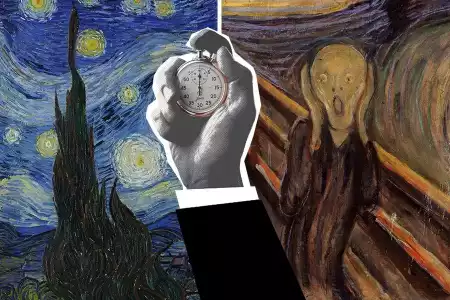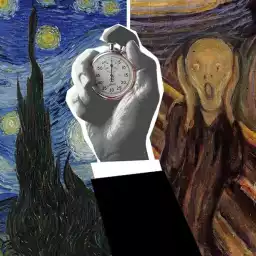
Art Quiz: Which Came First?
Test Your Knowledge of Historical Firsts in Art
Step into the "Which Came First? Art Edition", a captivating quiz that tests your knowledge of art history! Can you determine which art movement or masterpiece was created first?
Explore pivotal moments from the Renaissance to Modernism, and challenge yourself to identify the chronology of artistic innovations. Whether you're an art aficionado or just curious about art history, this quiz offers an engaging way to deepen your appreciation of art's evolution.
Ready to embark on a visual journey through art history? Let’s see how well you can trace the origins of artistic movements and works!
Start the Art Firsts Quiz
Discover Which Came First in Art
-
Which movement emerged first, Impressionism or Cubism?
Impressionism emerged first. Impressionism, characterized by its use of light and brush strokes to capture the essence of a subject, began in the 1860s in France. The movement's name comes from the title of a Claude Monet work, "Impression, Sunrise" ("Impression, soleil levant"), which was exhibited in 1874. Cubism, on the other hand, emerged in the early 20th century around 1907, led by artists Pablo Picasso and Georges Braque, focusing on abstract shapes and overlapping planes. Therefore, Impressionism predates Cubism by about four decades.
- Impressionism
- Cubism
-
Who painted their masterpiece first, Van Gogh with "Starry Night" or Monet with "Impression, Sunrise"?
Claude Monet painted "Impression, Sunrise" first. Monet's "Impression, Sunrise," which gave Impressionism its name, was painted in 1872 and first exhibited in 1874. Vincent van Gogh's "Starry Night," one of his most famous works, was painted later, in 1889, during his stay at the Saint-Paul-de-Mausole asylum in Saint-Rémy-de-Provence, France. Therefore, Monet's "Impression, Sunrise" predates Van Gogh's "Starry Night."
- Monet with "Impression, Sunrise"
- Van Gogh with "Starry Night"
-
Which iconic sculpture was completed first, Michelangelo's "David" or Rodin's "The Thinker"?
Michelangelo's "David" was completed first. Michelangelo completed the sculpture "David" in the early 16th century, specifically between 1501 and 1504. Auguste Rodin's "The Thinker," initially conceived as part of a larger piece called "The Gates of Hell" around 1880, was first cast in 1902. Thus, Michelangelo's "David" predates Rodin's "The Thinker" by nearly 400 years.
- Michelangelo's "David"
- Rodin's "The Thinker"
-
Which art school was founded first, Bauhaus or the Academy of Fine Arts Vienna?
The Academy of Fine Arts Vienna was founded first. The Academy of Fine Arts Vienna was established in 1692, offering a wide range of artistic disciplines. The Bauhaus, a school in Germany that combined crafts and the fine arts, and famous for its approach to design, was founded later, in 1919 by Walter Gropius in Weimar. Therefore, the Academy of Fine Arts Vienna predates Bauhaus by more than two centuries.
- The Academy of Fine Arts Vienna
- Bauhaus
-
Who created their notable self-portrait first, Frida Kahlo or Rembrandt?
Rembrandt created his notable self-portrait first. Rembrandt, known for his detailed and emotional self-portraiture, created numerous self-portraits throughout his life, from the 1620s until his death in 1669. Frida Kahlo, on the other hand, was born in 1907 and created most of her self-portraits in the 20th century. Therefore, Rembrandt's self-portraits precede Frida Kahlo's by about 270 years.
- Rembrandt
- Frida Kahlo
-
Which art technique was developed first, oil painting or watercolor painting?
Watercolor painting was developed first. Watercolor painting dates back to ancient times, with evidence of its use in Paleolithic Europe and ancient Egypt. It became a more formalized art form in the Middle Ages and the Renaissance. Oil painting, while it began to emerge in the 12th century in Europe, did not become the dominant painting medium until the 15th century with the innovation of techniques by the Van Eyck brothers. Therefore, watercolor painting predates oil painting by centuries.
- Watercolor painting
- Oil painting
-
Which famous museum opened first, the Louvre in Paris or the Prado in Madrid?
The Louvre in Paris opened first. The Louvre, originally built as a fortress in the late 12th century, was converted into a public museum during the French Revolution and officially opened in 1793. The Prado Museum in Madrid was established later, opening to the public in 1819 as a royal museum to exhibit works of art owned by the Spanish monarchy. Therefore, the Louvre predates the Prado by about 26 years.
- The Louvre in Paris
- The Prado in Madrid
-
Who was born first, Pablo Picasso or Georges Braque, both known for pioneering Cubism?
Georges Braque was born first. Braque was born on May 13, 1882, in Argenteuil, France. Pablo Picasso, his collaborator in the development of Cubism, was born later, on October 25, 1881, in Málaga, Spain. While Picasso is often more widely recognized, Braque's contributions to Cubism and modern art were equally significant. Therefore, Georges Braque was born before Pablo Picasso.
- Georges Braque
- Pablo Picasso
-
Which architectural marvel was completed first, the Sistine Chapel ceiling or the Taj Mahal?
The Sistine Chapel ceiling was completed first. Michelangelo painted the ceiling of the Sistine Chapel between 1508 and 1512. The Taj Mahal, on the other hand, was constructed later, with its construction beginning in 1632 and completing in 1653. The Sistine Chapel ceiling, with its iconic frescoes, predates the construction of the Taj Mahal, a symbol of love and one of the world's most renowned architectural beauties. Therefore, the Sistine Chapel ceiling predates the Taj Mahal by over 120 years.
- The Sistine Chapel ceiling
- The Taj Mahal
-
Who had their first solo exhibition first, Jackson Pollock or Mark Rothko?
Mark Rothko had his first solo exhibition first. Rothko, born in 1903, had his first solo show in New York at the Contemporary Arts Gallery in 1933. Jackson Pollock, born in 1912, had his first solo exhibition a bit later, in 1943, at Peggy Guggenheim's Art of This Century Gallery in New York City. Both artists became central figures in the American Abstract Expressionist movement, but Rothko achieved this milestone earlier in his career. Therefore, Mark Rothko had his first solo exhibition before Jackson Pollock.
- Mark Rothko
- Jackson Pollock
-
Which artistic medium was used first, lithography or screen printing?
Lithography was used first. Lithography, a printing process that uses chemical processes to create an image, was invented in 1796 by the German author and actor Alois Senefelder as a cheap method of publishing theatrical works. Screen printing, though it has roots in ancient stenciling techniques, was not developed into the more modern form known today until much later, with significant advancements occurring in the 20th century. Therefore, lithography predates screen printing by over a century.
- Lithography
- Screen printing
-
Who created a work featuring abstract expressionism first, Kandinsky or Pollock?
Kandinsky is often credited with creating the first purely abstract works. While Wassily Kandinsky, born in 1866, began exploring abstract painting in the 1910s, Jackson Pollock, born in 1912, did not start his foray into abstract expressionism until the 1940s. Kandinsky's first abstract watercolor, painted in 1910, is considered one of the first works of abstract art. Therefore, Kandinsky engaged with abstract expressionism before Pollock.
- Kandinsky
- Pollock
-
Which iconic piece of art was created first, "The Scream" by Edvard Munch or "Guernica" by Picasso?
"The Scream" by Edvard Munch was created first. Munch's "The Scream," which has become an iconic image of human anxiety, was painted in 1893. Pablo Picasso's "Guernica," a powerful political statement against the brutality of the Spanish Civil War, was created later, in 1937. Therefore, "The Scream" predates "Guernica" by over 40 years.
- "The Scream" by Edvard Munch
- "Guernica" by Picasso
-
Who was active in their art career first, Leonardo da Vinci or Albrecht Dürer?
Leonardo da Vinci was active in his art career first. Leonardo da Vinci, born in 1452, was active in the late 15th and early 16th centuries. His career as an artist, inventor, and scientist spanned the height of the Renaissance. Albrecht Dürer, born in 1471, was a leading figure in the Northern Renaissance, but his major works date from the early 16th century onwards. Therefore, Leonardo da Vinci's career predates Albrecht Dürer's.
- Leonardo da Vinci
- Albrecht Dürer
-
Which ancient site was constructed first, the Moai statues of Easter Island or Stonehenge?
Stonehenge was constructed first. The construction of Stonehenge began around 3000 BC and continued in phases until around 1600 BC. The Moai statues of Easter Island, on the other hand, are believed to have been carved between 1400 and 1650 AD. While both are ancient sites of significant historical and cultural importance, Stonehenge's construction predates that of the Moai statues by several millennia.
- Stonehenge
- The Moai statues of Easter Island

Major Art Movements
Tracing the lineage of art movements reveals not just the evolution of styles and techniques, but also reflects the shifting tides of society and culture.
Ancient Art (30,000 BCE - 400 CE)
The journey begins with the Paleolithic cave paintings found in places like Lascaux, which date back to around 17,000 BCE, displaying early human creativity with depictions of animals and human figures. This was followed by the sophisticated sculptures and pottery of Ancient Mesopotamia around 3500 BCE, and then by the Ancient Egyptians, who from 3000 BCE onwards refined wall paintings and structures, mirroring their quest for eternity.
Classical Art (500 BCE - 500 CE)
The Greek Classical period (480-323 BCE) introduced dramatic sculptures and architectural orders (Doric, Ionic, and Corinthian), epitomized by the Parthenon. Following the Greeks, Roman art thrived, assimilating Greek styles into its frescoes, mosaics, and monumental structures like the Colosseum (completed 80 CE).
Medieval Art (500 - 1400 CE)
Early Christian art gave way to Byzantine Art around 330 CE with the founding of Constantinople, known for its illuminated manuscripts and mosaics. The Romanesque style emerged in 1000 CE, marked by robust architectural forms and vivid paintings. It gracefully transitioned into the Gothic period by the 12th century, celebrated for its stained glass windows and sky-reaching cathedrals.
Renaissance (1400 - 1600 CE)
The Renaissance began in Italy, sparked by a renewed interest in classical philosophies and art. Innovators like Leonardo da Vinci and Michelangelo pushed artistic boundaries, creating masterpieces such as the Mona Lisa (c. 1503-1506) and the Sistine Chapel ceiling (c. 1508-1512).
Baroque and Rococo (1600 - 1750 CE)
Baroque art, with its emotional intensity and dramatic contrasts, was exemplified by artists like Caravaggio and Rembrandt. This period was succeeded by the lighter, more playful Rococo style around 1700, best embodied by the works of Antoine Watteau.
Neoclassicism, Romanticism, and Realism (late 18th - 19th century)
The late 18th century revived classical simplicity through Neoclassicism, as seen in Jacques-Louis David’s Oath of the Horatii (1784). Romanticism, which focused on emotion and nature, was popularized by artists like Eugène Delacroix. By the mid-19th century, Realism took root, with artists like Gustave Courbet depicting everyday life with unvarnished truth.
Modern Art (late 19th - 20th century)
This era began with Impressionism in the 1860s, pioneered by Claude Monet, who emphasized light and color over detail. Post-Impressionism followed, with artists such as Vincent van Gogh leading the way. The early 20th century saw groundbreaking movements like Cubism, pioneered by Pablo Picasso and Georges Braque, and Surrealism, with Salvador Dalí and Max Ernst reshaping perceptions of reality.
So... which came first?
We hope you found our quiz a fun way to learn the history of art. Each movement not only reflects the societal shifts and cultural landscapes of its time but also offers a window into the broader human experience.
Don't miss our main quiz Which came first?, covering a wide array of categories such as history, brands, music, and food. Challenge your knowledge and discover the origins of everyday items and world-changing events!